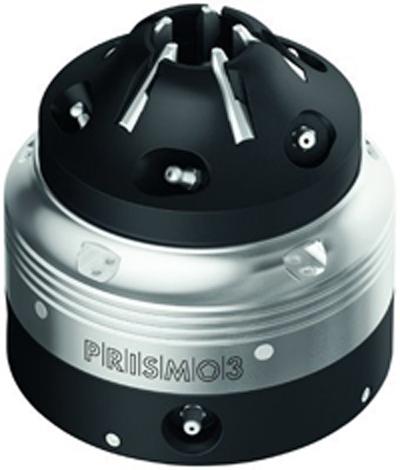
The SCHUNK PRISMO3 tool grinding toolholder directly clamps every shank diameter between 3mm and 20mm without the use of collet chucks or sleeves. The tool shank is automatically centered in the toolholder during the clamping process. The set-up time is reduced by up to 70 percent in comparison with conventional multi range grinding toolholders. Regardless of the tool diameter, the X-axis doesn‘t change, which means the chuck jaws remain in the identical axial position. This makes it possible to machine the widest range of drilling, reaming, and milling tools around the clock in unmanned operation without reprogramming the L1 measurement.
The design layout, the base sleeve, and the robust construction give the toolholder its high rigidity. Its sturdy jaw guidances prevent the grinding discs from swinging up and almost completely eliminate tube imbalance. The toolholder is rinsed with clean oil during grinding operation, which prevents dirt accumulation, and helps to maintain the high precision. Compact dimensions of 125mm x 125mm leave ample space for the tools, grinding process, and loading.
Contact Details
Related Glossary Terms
- chuck
chuck
Workholding device that affixes to a mill, lathe or drill-press spindle. It holds a tool or workpiece by one end, allowing it to be rotated. May also be fitted to the machine table to hold a workpiece. Two or more adjustable jaws actually hold the tool or part. May be actuated manually, pneumatically, hydraulically or electrically. See collet.
- collet
collet
Flexible-sided device that secures a tool or workpiece. Similar in function to a chuck, but can accommodate only a narrow size range. Typically provides greater gripping force and precision than a chuck. See chuck.
- gang cutting ( milling)
gang cutting ( milling)
Machining with several cutters mounted on a single arbor, generally for simultaneous cutting.
- grinding
grinding
Machining operation in which material is removed from the workpiece by a powered abrasive wheel, stone, belt, paste, sheet, compound, slurry, etc. Takes various forms: surface grinding (creates flat and/or squared surfaces); cylindrical grinding (for external cylindrical and tapered shapes, fillets, undercuts, etc.); centerless grinding; chamfering; thread and form grinding; tool and cutter grinding; offhand grinding; lapping and polishing (grinding with extremely fine grits to create ultrasmooth surfaces); honing; and disc grinding.
- milling
milling
Machining operation in which metal or other material is removed by applying power to a rotating cutter. In vertical milling, the cutting tool is mounted vertically on the spindle. In horizontal milling, the cutting tool is mounted horizontally, either directly on the spindle or on an arbor. Horizontal milling is further broken down into conventional milling, where the cutter rotates opposite the direction of feed, or “up” into the workpiece; and climb milling, where the cutter rotates in the direction of feed, or “down” into the workpiece. Milling operations include plane or surface milling, endmilling, facemilling, angle milling, form milling and profiling.
- shank
shank
Main body of a tool; the portion of a drill or similar end-held tool that fits into a collet, chuck or similar mounting device.
- toolholder
toolholder
Secures a cutting tool during a machining operation. Basic types include block, cartridge, chuck, collet, fixed, modular, quick-change and rotating.

